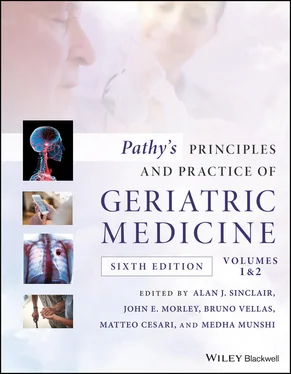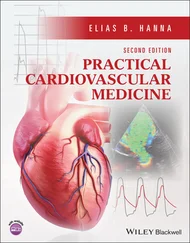Pathy's Principles and Practice of Geriatric Medicine
Здесь есть возможность читать онлайн «Pathy's Principles and Practice of Geriatric Medicine» — ознакомительный отрывок электронной книги совершенно бесплатно, а после прочтения отрывка купить полную версию. В некоторых случаях можно слушать аудио, скачать через торрент в формате fb2 и присутствует краткое содержание. Жанр: unrecognised, на английском языке. Описание произведения, (предисловие) а так же отзывы посетителей доступны на портале библиотеки ЛибКат.
- Название:Pathy's Principles and Practice of Geriatric Medicine
- Автор:
- Жанр:
- Год:неизвестен
- ISBN:нет данных
- Рейтинг книги:3 / 5. Голосов: 1
-
Избранное:Добавить в избранное
- Отзывы:
-
Ваша оценка:
- 60
- 1
- 2
- 3
- 4
- 5
Pathy's Principles and Practice of Geriatric Medicine: краткое содержание, описание и аннотация
Предлагаем к чтению аннотацию, описание, краткое содержание или предисловие (зависит от того, что написал сам автор книги «Pathy's Principles and Practice of Geriatric Medicine»). Если вы не нашли необходимую информацию о книге — напишите в комментариях, мы постараемся отыскать её.
Pathy’s Principles and Practice of Geriatric Medicine
Pathy's Principles and Practice of Geriatric Medicine — читать онлайн ознакомительный отрывок
Ниже представлен текст книги, разбитый по страницам. Система сохранения места последней прочитанной страницы, позволяет с удобством читать онлайн бесплатно книгу «Pathy's Principles and Practice of Geriatric Medicine», без необходимости каждый раз заново искать на чём Вы остановились. Поставьте закладку, и сможете в любой момент перейти на страницу, на которой закончили чтение.
Интервал:
Закладка:
Another mechanism responsible for the pathogenesis of anaemia of chronic disease is diminished production and response to renally produced erythropoietin – a bone‐marrow stimulating hormone. Erythropoietin production is inversely regulated by haemoglobin and tissue oxygenation levels. Inflammatory cytokines have been shown to damage erythropoietin‐producing renal cells and also down‐regulate erythropoietin‐binding receptors on other cells, leading to decreased bone marrow production of RBCs. 52Pro‐inflammatory cytokines also directly damage erythroid precursor cells in the bone marrow and RBCs in the blood, shortening the lifespan of these cells through cytokine‐mediated apoptosis and free radical damage. These prohibitory mechanisms ultimately decrease the number of circulating RBCs. 53,54
Anaemia of chronic disease is diagnosed by laboratory studies. Typically, it manifests as a normocytic anaemia with low haemoglobin, low to normal serum iron, low to normal transferrin, low transferrin saturation, and normal to elevated ferritin ( Figure 22.3). Cytokine levels, which are not usually measured in the clinical setting, are elevated. Surrogate markers of inflammation, however, such as C‐reactive protein (CRP) and erythrocyte sedimentation rate (ESR), are more readily obtainable than cytokine levels and are also elevated. 13Ferritin, despite being categorized as an acute‐phase reactant, is the most useful test in differentiating anaemia of chronic disease from other anaemias and particularly from IDA. As discussed previously, a ferritin level of less than 30 ng/mL has a high positive predictive value for IDA, whereas a ferritin level of greater than 100 ng/mL indicates probable anaemia of chronic disease. 20Elevated ferritin reflects the increased storage and diminished usability of iron, which is the hallmark of anaemia of chronic disease. For equivocal levels of ferritin (30–100 ng/mL), the soluble transferrin receptor may be helpful in distinguishing anaemia of chronic disease from IDA and identifying concomitant IDA and anaemia of chronic disease. 55Soluble transferrin receptor levels are increased in IDA but are normal in anaemia of chronic disease because of the prohibitive effects of cytokines on its expression. 56
The definitive treatment of anaemia of chronic disease relies heavily on the eradication of the inflammatory or chronic disease process. This is often difficult or impossible to achieve, particularly in debilitated, frail, or ill elderly individuals. Supplemental iron is not recommended for the treatment of anaemia of chronic disease unless concomitant iron deficiency is present. It should not be given in those with ferritin levels greater than 100 ng/mL because of a high risk of adverse effects. 57The pathophysiology of anaemia of chronic disease is such that iron is poorly absorbed and bound up in its storage form. Any supplemental iron given will be retained in the reticuloendothelial system or ferritin and not released into the bone marrow to be used as a substrate for RBC production.
Erythropoietic‐stimulating agents are currently approved by the US Food and Drug Administration (FDA) for individuals with anaemia of chronic disease who have cancer and are receiving chemotherapy or for those who have human immunodeficiency virus (HIV) and are receiving myelosuppressive treatment. 58Because of the rapid increase in bone marrow RBC production, absolute iron deficiency is frequently common when using erythropoietin‐stimulating agents, and concomitant iron therapy is often necessary. 59Iron studies should be checked prior to treatment initiation and during treatment with bone‐marrow stimulating agents. To monitor treatment response to erythropoietic‐stimulating agents, haemoglobin levels should be checked every two to four weeks, with a target haemoglobin level of 11–12 g/dL. 60It is important to note that while these agents improve haemoglobin levels and potentially quality of life, their effects are limited. Erythropoietic‐stimulating agents do not treat the underlying disease processes resulting in the anaemia.
In summary, anaemia of chronic disease is considered a functional iron deficiency that is caused by an underlying inflammatory or chronic disease process. It is diagnosed by a low haemoglobin, low to normal serum iron levels, and normal to elevated ferritin levels. Typically, CRP and ESR will also be elevated. This anaemia is historically difficult to treat because the crux of the treatment relies on the elimination of the chronic disease and inflammation. In some cases, erythropoietic‐stimulating agents will improve haemoglobin levels, but care must be taken to diagnose and treat any concomitant iron deficiency for these agents to be effective.
Anaemia of chronic kidney disease
Anaemia of chronic kidney disease (CKD) is quite prevalent in older adults because of the high prevalence of CKD in the older population. In a report released by the National Kidney Foundation, 45–70% of adults over 75 meet the diagnostic criteria for CKD (i.e. glomerular filtration rate of less than 90 mL/min). 61In another study focused specifically on nursing home residents with a diagnosis of CKD, 51–60% were also found to have anaemia. 62Although anaemia is deleterious in any individual, it is thought to be particularly onerous in those with CKD who are receiving haemodialysis. In a large retrospective study of CKD patients on dialysis, haemoglobin levels of less than 8 g/dL were associated with a twofold risk of death when compared to the risk associated with haemoglobin levels of 10–11 g/dL. 63Correction of anaemia in individuals with CKD has been positively associated with an improvement in quality of life as well as decreased mortality. 64
The pathophysiology of anaemia of CKD and anaemia of chronic disease share many overlapping features because of the underlying inflammation present in both conditions. Inflammation leads to functional iron deficiency from deranged iron homeostasis and a limited amount of free iron available to use in the production of new RBCs. In anaemia of CKD, hepcidin levels are more elevated than in anaemia of chronic disease, which is presumably because of reduced renal clearance of the peptide, resulting in even greater functional iron deficiency. An even more pronounced deficit of renally produced erythropoietin occurs due to the intrinsic renal dysfunction, leading to reduced bone marrow stimulation and impaired RBC production. Additionally, uraemia and elevated levels of unfiltered toxins in the blood can cause uraemia‐associated platelet dysfunction, leading to increased bleeding and worsening anaemia. Toxins also shorten RBC lifespan from the typical 120 days to 30 or 40 days. 65Individuals with CKD who are on dialysis have increased blood losses through frequent phlebotomy and haemodialysis. The cumulative effect of these mechanisms can produce severe anaemia (haemoglobin levels less than 8 ng/dL) that is frequently refractory to treatment.
The National Kidney Foundation recommends a workup of anaemia of CKD when haemoglobin levels fall below 12 g/dL in men and 11 g/dL in women. 66Anaemia of CKD is routinely diagnosed by laboratory studies. Typically manifesting as a normocytic, normochromic anaemia, the diagnosis requires impaired renal function as determined by glomerular filtration rate (GFR), low haemoglobin, low to normal serum iron, normal to high ferritin, low to normal transferrin saturation, and normal to high TIBC. The reticulocyte count is low in proportion to degree of anaemia ( Figure 22.3). Erythropoietin production is most severely depressed once the creatinine clearance falls below 30 mL/min but also progressively decreases with a decline in creatinine clearance under the normal range (under 90 mL/min). 67It is unclear how diagnostically useful erythropoietin levels are in anaemia of CKD, as they may be normal or even slightly increased above normal ranges but are low in proportion to the degree of anaemia present. 68Additionally, the currently available commercial assays are unable to specifically measure biologically active erythropoietin, making their usefulness controversial. 69Concurrent iron deficiency and anaemia of CKD is quite common, as RBC turnover is increased and bleeding losses through phlebotomy, uraemia‐associated platelet dysfunction, and haemodialysis are prominent.
Читать дальшеИнтервал:
Закладка:
Похожие книги на «Pathy's Principles and Practice of Geriatric Medicine»
Представляем Вашему вниманию похожие книги на «Pathy's Principles and Practice of Geriatric Medicine» списком для выбора. Мы отобрали схожую по названию и смыслу литературу в надежде предоставить читателям больше вариантов отыскать новые, интересные, ещё непрочитанные произведения.
Обсуждение, отзывы о книге «Pathy's Principles and Practice of Geriatric Medicine» и просто собственные мнения читателей. Оставьте ваши комментарии, напишите, что Вы думаете о произведении, его смысле или главных героях. Укажите что конкретно понравилось, а что нет, и почему Вы так считаете.












